Table of Contents
11
Project Based Learning
Objectives
After completing this Chapter, the student will be able to:
- Know about project and project based learning
- explore the possibilities of executing a project,
- experience the concept of ‘learning by doing’,
- seek solutions to problems, using CCT tools.
- Understand the various processes involved in project based learning and the importance of team work in project based learning
- develop projects for various real life situations,
- work in realistic contextualised problem-solving environments,
- realise the success of a project by experiencing the desired output.
- Apply knowledge and understanding of project based learning processes in new situations
- improve communication skills,
- enhance self-confidence,
- appreciate that a project can be executed in different ways,
- build up teamwork and leadership skills.
“An idea that is developed and put into action is more important than idea that exists only as an idea.”
Gautam Buddha
Introduction
Project based learning gives a thorough practical exposure to a problem upon which the project is based. Projects are developed generally in groups where students can learn various things such as working together, problem solving, decision making, and investigating activities. Project based learning involves the steps such as analysing the problem, formulating the problem into small modules, applying the mechanism or method to solve each module and then integrating the solution of all the modules to arrive at the complete solution of the problem. To solve a problem it is required that those who work on it gather the relevant data and process it by applying a particular method. Data may be collected as per the requirement of the project in a particular format. All the team members should be associated to accomplish the task. After collecting data, it should be processed to solve the problem. The results should be reported in a predetermined format.
1.1 MODULAR APPROACH TO PROJECTS
There are several approaches to execute a project such as modular approach, top down approach and bottom up approach. Amongst the most common forms of project based learning, the modular approach to execute a project is the most reliable technique. A structured or a modular approach to a project means that a project is divided into various manageable modules and each of the modules has a well defined task to be performed with a set of inputs. This would lead to a set of outputs which when integrated leads to the desired outcome.
Steps in Project Based Learning
The different steps involved in Project Based Learning figure 11.1 are :
1. Identification of a project: The project idea may come through any real life situation. For example one could think of doing a project for organising a seminar. One needs to understand the usefulness of the project and its impact. Students must be encouraged to undertake interdisciplinary projects.
2. Defining a plan: Normally for any kind of project, there are several project members involved in it. One project leader has to be identified. The roles of project leader and each project member have to be clearly defined. Students who are performing a project must be assigned with specific activities. The various tools for executing these activities must be known. To obtain a better solution, one should always think of the extreme situations.
3. Fixing of a time frame and processing: Every project is a time relevance project. A student must understand the importance of time frame for completion of the project. All the activities which are
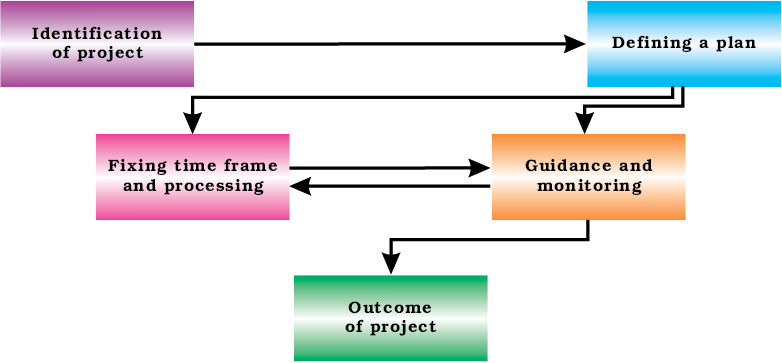
Figure 11.1 : Steps in Project Based Learning
performed in the projects require certain amount of time. Every project must be well structured and at the same time it must be flexible in its time frame.
4. Providing guidance and monitoring a project: Many times, the participants in the project get stuck up with the process and become unable to proceed further. In such a case or otherwise they need guidance. Guidance can be obtained from various resources such as books, websites and experts in the field. While it is essential that project leader should ensure monitoring of the project, the guide teacher also helps in monitoring the project.
5. Outcome of a project: One needs to understand what can be the outcome of the project. The outcome can be single or it can be multiple. The outcome of the project can be peer reviewed and it can be modified as per the feedback from users or experts.
Let us consider a project “Organising a seminar for career counselling in a school”. The project can be broken into sub–tasks such as :
- Drafting the concept note that would establish the need for organising such a seminar,
- Arranging a hall for the seminar having proper sitting arrangements with audio–visual facilities,
- Making a list of participants and sending information to the participants,
- Sending invitations to the guests,
- Arranging career counsellors to speak at the seminar,
- Arranging for hospitality to the guests, etc.
The above example demonstrates the need of a modular approach to a project. A separate team of people may be assigned to perform each of the above listed sub–tasks.
The advantage of modular approach is that it is much easier to design a smaller task. Also, some of the modules can be re–used if they have already been done for some other project. For example the list of participants may be re–used if it was already prepared for some other seminar. It also ensures that some tasks can be done in parallel which is very helpful for executing a project in short time.
11.2 TEAMWORK
Many real life tasks are very complex and require a lot of people to contribute in achieving them. An effort made by many people together in order to accomplish a task is called teamwork.
For example, in many sports, there is a team of players. These players play together to win a match. Take an example of a cricket team. We find that even if a bowler bowls a good ball but if the fielder cannot take a catch then a wicket cannot be taken. So, in order to take a catch we require efforts of a bowler and also of fielders. To win a cricket match, contributions from all the team members in all the three areas batting, bowling and fielding are required.
11.2.1 Components of Teamwork
Apart from technical proficiency, a wide variety of other components make a successful teamwork. It comprises of skilled team members with specific roles, to achieve the goal.
Communicate with Others
When a group of people performs one job, it is necessary to have an effective communication between the members of the team. Such communication can be done via e-mails, telephones or by arranging group meetings. This helps the team members to understand each other and to sort out problems to effectively achieve the goal.
Listen to Others
It is necessary to understand the ideas of others while executing a job together. This can be achieved when the team members listen to each other in group meetings and follow steps that are agreed upon.
Share with Others
Ideas, images and tools need to be shared with each other in order to perform a job. Sharing is an important component of teamwork. A person in the team who is well versed in a certain area should share his expertise and experience with others to effectively achieve the goal within the time frame.
Respect for Others
Every member of the team must be treated respectfully. All the thoughts and ideas that are put forth in the group meetings may be respected and duly considered. Not respecting the views of a particular member may cause problems and that particular team member may not give his best.
Help Others
A helping hand from every member is a key to success. Sometimes help from people who are not a part of the team is also obtained in order to accomplish a job.
Participate
All the team members must be encouraged by each other to participate in completing the project and also in discussions in group meetings. Also every member should take an active participation so that they feel their importance in the team.
11.3 A SUCCESSFUL LEARNING EXPERIENCE
In order for projects to be successful learning experiences, each student should:
- have a sense of participation,
- have enough time to work on a project,
- have some choices in the creation of questions, approaches, etc.,
- possess the skills to work with others,
- have the knowledge necessary to explore questions that arise,
- understand the teacher’s method of evaluation.
Some of the projects with the objective to provide exposure to students to undertake and implement various aspects of real life projects, such as creating a magazine, Awareness of Pulse Polio Programme, Robotics, Health Analyser System, farewell to class XII, Know your District/Region, create a website as teamwork and establishment of a computer network are given below :
11.3.1 School Magazine
Project Title : Creation of School Magazine
Description
The project aims at creating a monthly magazine of your school (Figure 11.2), which should include articles describing the latest happenings and achievements in the field of sports, academics and other various activities that have occurred during the past month. It should not include any article that is a copy of copyright material. It must be created by the students only.

Figure 11.2 : Creating school magazine
Guidelines
Make a group of students to undertake a project on Producing School Magazine. This group should be divided further into several subgroups of 2-3 students to carry out the work on similar lines as mentioned below:
(a) Task force : This group should be involved in motivating the students for writing and submitting the material for the school magazine.
(b) Students Articles : This group should collect the articles submitted by students on areas of their interest. Articles may also include quiz, humour, puzzles, and poems, etc.
(c) Sports Section : This project team should collect all the information regarding the sports activities of the school like any zonal or district level games, team members who took part, etc.
(d) Achievements in the field of Academic/Cultural activities : This team should collect materials on the cultural and academic events of the school.
(e) Illustrations : This group should create the illustrations, drawings, etc. for making the Magazine more attractive and informative.
(f) Editing and layouts for printing : Editorial group should confirm that the articles are original writings of the students. After verification, the editorial group may compile all the collaborative works done by the rest of the groups and should create a layout on the computer. After creating the layouts the editing groups should show their layout to the teacher under whose supervision the project is going on.
After the layout has been finalised the magazine should be printed and can be distributed among the students and teachers of the school.
Outcome
The School Magazine.
11.3.2 Pulse Polio
Project Title : Report on “Pulse Polio Sunday” held at your village/town.
Description
The goal of the project is to help and create a monitoring report for the Pulse Polio Program in your region (Figure 11.3). The group should work to promote the Polio Eradication Movement taken up by the Government of India.
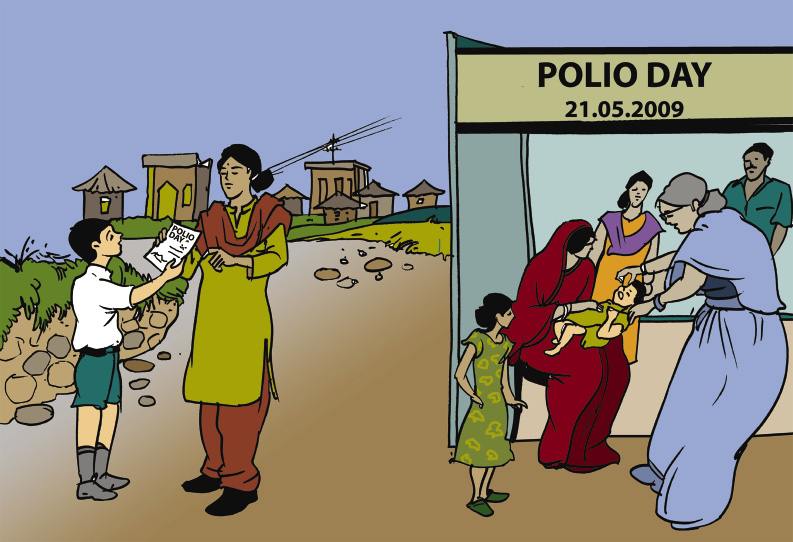
Figure 11.3 : Pulse polio camp
Guidelines
Let us create a group of 8–10 students. This group should be divided further into sub-groups of 2–3 students to carry out a specific work each covering different regions.
(a) Task force : The students in this group should contact the Pulse-Polio Programme coordinators at the pulse polio centre in their locality.
(b) Motivation group : This group should create digital posters on polio vaccination that can be used to promote pulse-polio awareness among people of their area.
(c) Data collection : After the Pulse Polio Programme scheduled for the month they should collect the data that how many children have been vaccinated and how many are still remaining in their locality.
(d) Report generation : The chart representing the data should be drawn using appropriate computer software.
The data of polio vaccination can be recorded for the whole year.
Outcome
“The Pulse Polio Report” highlighting the status of Polio Eradication Programme in your village/town created using some presentation software such as PowerPoint or Impress.
11.3.3 Robotics
Project Title : Application of Robots in different fields
Description
The purpose of the project is to prepare a report on uses of robots figure 11.4 in different fields. It will also help students to realise the extent of automation and efficiency accomplished by robots in various fields of industry.

Figure 11.4 : Use of robots in industry
Guidelines
Form a group of 8–10 students for the project. This group should be divided further into subgroups of 2–3 students to carry out specific tasks on the similar lines as mentioned below :
(a) One subgroup should collect the information about different types of robots through websites or otherwise.
(b) Another subgroup should collect the information on various industries who are using specialised robots in their manufacturing units and to suggest the most suitable site for visit.
(c) Third subgroup should prepare a report on various functions/tasks performed by robots in the manufacturing unit.
(d) Fourth subgroup should prepare a module showing advantages of using robots.
Outcome
A compiled document describing the functions, and components used in robots and the tasks performed by them in a particular manufacturing workshop along with relevant information and pictures.
11.3.4 KNOW YOUR HEALTH
Project Title : Know your Health : Development of a System to record and analyse the data related to health of students in a class/school.
Description
This is a project related with collecting and analysing the data related to health of the students in a particular school/class. This project involves collecting data of students such as height, weight, their day to day food habits, their past health history etc. Some data related with their parents will also be collected (Figure 11.5).
The data will be collected by survey and this data will be stored in some Data Management System. It can then be analysed and some preliminary measures can be suggested to students and their parents.
This will help the students to maintain their health and hygiene and hence they can concentrate more on their studies.
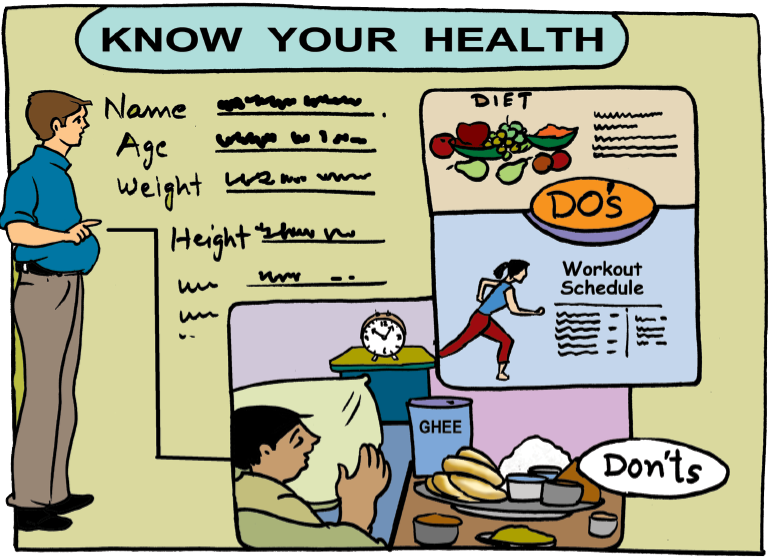
Figure 11.5 : Managing data related to health
Guidelines
(i) Decide a group of students from whom data is to be collected. A group of 2-3 students can collect data of 20 students.
(ii) Set the format of data to be collected by consulting a doctor. Note some useful information such as height, weight, food habits and exercise habits etc.
(iii) Collect the data by survey i.e. by distributing formats among students.
(iv) Get data entered into some database system such as MS Access/MS Excel.
(v) Check the entered data.
(vi) Prepare some reports/graphs from collected data. Graphs can be student wise/class wise.
(vii) Show these graphs to doctor and obtain certain suggestions for each student.
(viii) Distribute suggestions to students/parents.
(ix) Take feedback from students/parents regarding use of this project and use it for improvement.
FORMAT OF DATA COLLECTION
1. Name of the student : ..................
2. Class : ..................
3. Age (in years) : ..................
4. Height (in cm) : ..................
5. Weight (in kg) : ..................
6. Food Habits
a. Number of times food taken (2/3/4) :
b. Type of food (veg/non-veg)
c. Regular food (Chapati, Rice, Dal, Veg)/Non regular food (fast food) :
7. Exercise habits
a. Do you exercise daily?: (Yes/No) :
b. If Yes, how many minutes?:
c. Type of exercise: (Running/Play/on machine/Yoga/Surya
Namaskar/other)
8. Time to wake up : ..................
9. Time to go to bed : ..................
10. Past medical history : ..................
11. Write your normal daily schedule

Outcome
Report on data related to health of students.
11.3.5 Farewell To Class 12th
Project Title : To organise a school event as ‘Farewell to class 12th’ as a collaborative project.
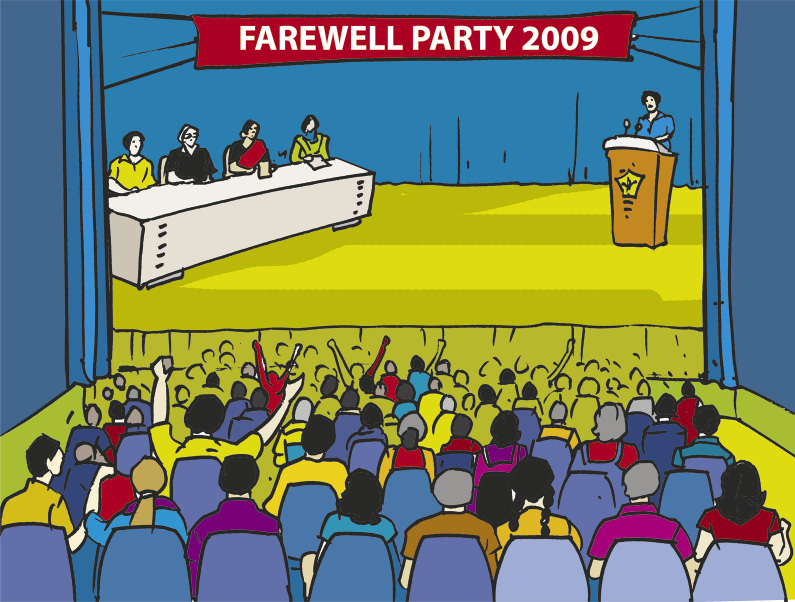
Figure 11.6 : A Farewell Party
Description
The aim of the project is to organise the event with collaboration of students and using CCT tools (Figure 11.6).
(a) Identification of Participants
The participants would be students of class 12th, class 11th, teachers, chief guest and special invitees. Among the participants, class 11th students are key members who will be organising the event. Class 12th students, teachers, chief guest and special invitees constitute the audience. The role of class 11th students, who are arranging the event, is more proactive than others. The first task is to get the list of students and teachers. One way of getting the names of the students of class 11th and 12th,
is to ask one member of each section to get the details of the respective class. Another way is to get the information directly from class Attendance Register or school website.
(b) Planning
All events should start with a plan and there is a need for regular discussions among participants. Initially a group meeting is to be organised to discuss the objective, requirement and proposed line of action. Conventional way of holding a meeting is to inform students on the notice board or through class announcement. Another way of informing all the participants is by sending e-mails. An agenda of the farewell party is to be prepared and communicated to all members mentioning time, date and venue.
(c) Identification of Task
In the main event there are various subtasks which are to be delegated to different groups. Broadly the following tasks has to be assigned.
- Coordination of management for date, venue, chief guest and special invitees.
- Budget estimate.
- Collection of funds.
- Procurement of food and cold drinks.
- Procurement of gifts and mementoes.
- Organisation of cultural programme.
- Maintenance of accounts.
- Coordination and monitoring.
Guidelines
Use communication tools such as Messenger from any service provider such as Yahoo or own school e-mail service for creating task based groups. Members of each group should exchange information and get consolidated view. The decision can be then forwarded to coordination and monitoring group. The status of each task should be updated to the notice board or website or by sending the status report to all members through e-mails. This will create interest and enthusiasm in all the members whether he/she is involved directly or indirectly. A website can also be created where each member can post the status and notices regarding events.
(a) Delegation of Task
Once the subtasks are identified, the jobs have to be delegated to various groups. During allocation of tasks, it should be kept in the mind that representatives of all the classes are properly selected.
(b) Estimation
Conventionally the members allocate funds in different heads as per assumption and guess. Each group member can calculate the expected expense. For better estimation, members can do a market survey to explore the current market rate of various items and the prospective supplier. Market survey can be done directly or the same information can be gathered from internet or by telephone. This will give fair idea about the expense and contribution from each student. The same can be informed to all the members with details of where and to whom the contribution is to be submitted.
(c) Collection of Funds
All the members can deposit their contribution to the designated member of their respective classes. The same can be updated in the database, and if required the same can be updated in the website also. A system can be developed to track the collection and expense.
(d) Allocation of Funds
As per the estimation each group would be allocated the funds. The group would regularly update the expenses, by keeping, bill/receipt of expenses made.
(e) Cultural Programme
There would be maximum participation of members in this group and would require coordination and regular meetings for making the event interesting. This task can be coordinated by e-mails. E-mail is a very effective tool for communication and can be used for communicating about rehearsal schedules. It will be better to use a unified messaging service for communication and event management.
Outcome
A good organisation of farewell party to outgoing students of class 12th.
11.3.6 Know Your District
Project Title : Development of a system to record data related with your district to produce some useful information of the district.
Description
This is a project related with collection of information of the home district so that every student will be aware of the historical, geographical, political, cultural information of the home district. This will help the students to know many things about their home district. It ultimately helps them in their studies, since this information can be used in various subjects such as history, geography and science.
Guidelines
1. Make a group of students. This group should be divided further into sub-groups. Each sub-group is allotted one area of information to be collected such as one sub-group will collect historical information, second sub-group will collect the geographical information and third sub-group will collect the political information and so on.
2. Collect the information of the district as per the format given. It can be done by consulting the concerned teacher of the subject. Such as group collecting historical data will consult with history teacher, group collecting geographical data will consult with geography teacher, and those collecting political data will consult with political teacher and so on.
3. Collect the data from various sources such as books, magazines, newspapers, Internet etc.
4. The concerned teachers should validate the collected data.
5. Enter the data in spreadsheet and prepare various charts and graphs so that the numerical information gets displayed in pictorial form.
6. Display these charts and graphs at various places in class/school.
7. Conduct small interactive sessions to make every student aware of the collected information.
8. Draw some conclusions from the collected information, which was normally not known, to the students.
9. Take the feedback from the students/teachers on the activity and use this for improvement.
Format for DATA COLLECTION
1. Historical information about the district
(a) Date of formation:
(b) Special features (tourist places/historical monuments/places of worship):
(c) Earlier rulers:
(d) History of the place (pre and post Independence) :
2. Geographical information
(a) Population:
(b) Area covered:
(c) Number of villages:
(d) Main productions of crops:
(e) Number and names of rivers/lakes:
3. Educational information
(a) Number of schools:
(b) Number of colleges:
(c) Number of students in school:
(d) Number of students in college:
(e) Name of universities:
(f) Professional courses offered:
(g) Number of Anganvadies:
4. Political information
(a) Number and names of the assembly constituents:
(b) Number and names of the parliament constituents:
(c) Names of earlier MPs:
(d) Name of present MP and MLA:
(e) Political parties and their percentage of voting in a district:
(f) Percentage of women participation in the local government body:
Outcome
A brief report on the history, geography and political information of your home district.
11.3.7 Creating A Website As Teamwork
Project Title : Develop a website to gather and fetch the information on the web.
Description
You are familiar with various websites on the Internet. You have also learnt various tools, and acquired skills needed to develop the website. Now you are able to create a website for school, company, hotel, club, family or personal use, etc. (Figure 11.7). The steps for developing website are given below :
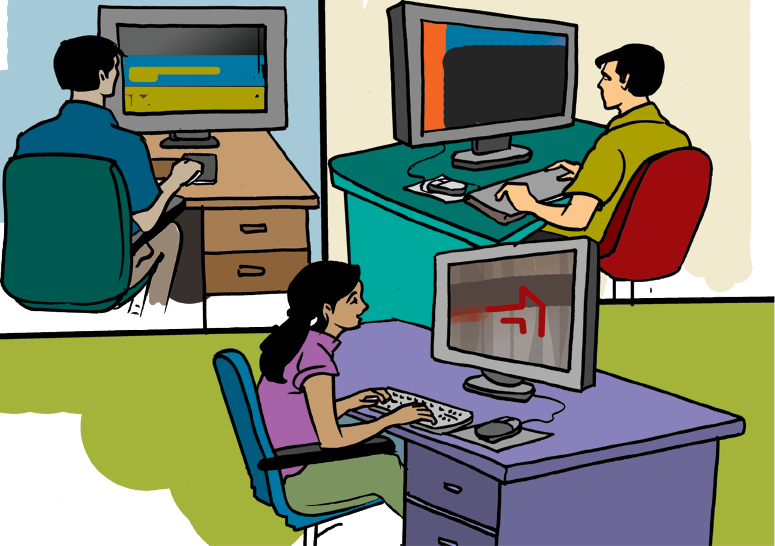
Figure 11.7 : Creating a website
(a) Planning : The purpose of making the website should be very clear among all team members. Create a detailed document containing all the information about the website.
(b) Designing : After drafting the document, your next step will be to design all the web pages using any web editor.
(c) Coding : Now, the team is ready to validate web pages using Java Scripting language with proper documentation. The coding team needs to submit their code in time to the team leader. After collection of all validated web pages, arrange them in proper location and folder.
(d) Testing Website : Once your website is ready, it will be tested by at least two members of the team for its smooth and performance based functionality. All members of the team must visit the website and also give suggestions to improve it.
(e) Review : After getting feedback from the team members, upload the website and submit it to any search engine, e.g. Google, Yahoo, bing etc.
Guidelines
1. Make it easy to verify the accuracy of the information on your site.
2. Ensure that there is a real organisation behind your site.
3. Ensure that honest and trustworthy people stand behind your site.
4. Make it easy to contact you.
5. Design your site so that it looks professional (or is appropriate for your purpose).
6. Avoid errors of all types, no matter how small they seem.
7. Make it user friendly i.e. easy to load, read, navigate, browse information and download etc.
Outcome
A complete website.
11.3.8 Establishment of A Computer Network
Project Title : Development of a computer network in the school.
Description
Suppose a school has many computers but they are not connected with each other. The students want to connect these computers to each other and want to access the Internet. Computers can be connected through switch, hub, router and server. Switch gives the best performance compared to hub and router provides path to the entire network and server manages all the processes such as IP generation, restriction, security etc.
Students should collect the resources such as LAN cable, switch, router etc. After collection, they should connect LAN cable from computers to switch, switch to server, server to router and router to cable of the net. Now configure the router from server and give the IP addresses to all the computers of this network and check the connectivity of the server to client. If connectivity is there then computer network is ready to function.
Items Required
- LAN cards, switch, router and LAN cable with connecter.
- Two LAN cards for the Server computer.
Procedure
- Look at the figure 11.8 of Computer Network.
- First of all manage all the computers in the desired location.
- Cut LAN cable according to the distance of the computer and the switch.
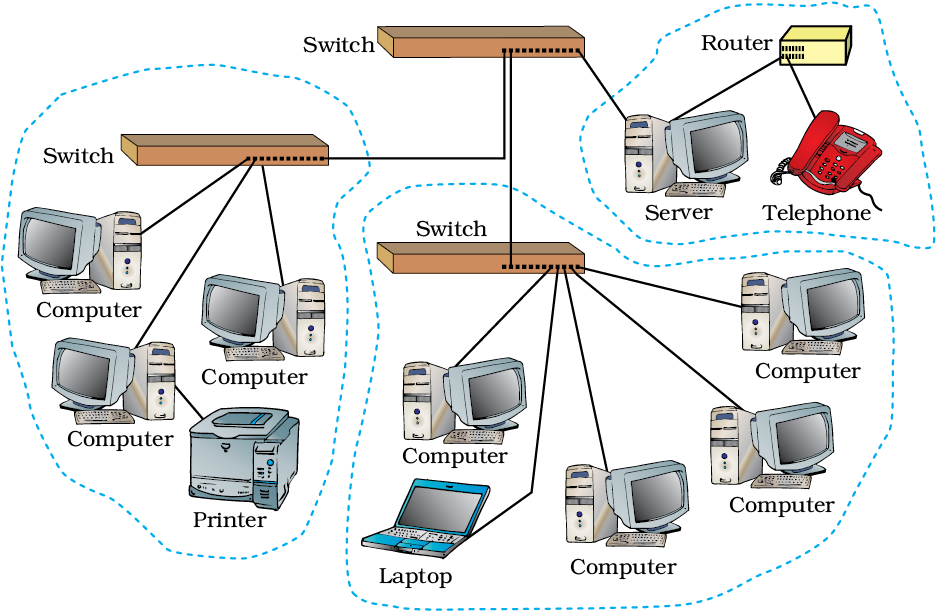
Figure 11.8 : A Computer Network
- Connect computers and switch by the LAN cable.
- Connect the switch to the LAN card of server computer through LAN cable.
- Connect second LAN card of the server to the router.
- Connect the Router to the telephone line having connection such as ISDN or Broadband connection.
- After connecting all the computers to the switch and router define the class of the IP address.
Class A comprises network address 1.0.0.0 to 127.0.0.0; Class B contains network address 128.0.0.0 to 191.255.0.0; Class C network address’s range from 192.0.0.0 to 223.255.255.0.
After defining IP range, configure Windows or Linux server.
Guidelines
- IP address of each computer should be unique.
- Keep security of the server computer very high.
Outcome
All the computers of the school are connected through network and Internet.
Project Title : Collaboration through Messenger.
There are many Messengers the Google, Yahoo etc. which provide the services requested like mail, chat, make voice call and send instant messages after logging in with your user account and password. Such utility is very useful in event management.
Illustration 1 : Yahoo Messenger
Invoke the Yahoo Messenger and enter login ID and password. After logging in the Yahoo Messenger, it will show the names of the persons highlighted who are on-line in your list as shown in figure 11.9 :

The different services are listed out in the Actions pull down menu. Move the mouse pointer on the particular action and click it to use it such as invite to conference as shown in figure 11.10.

After clicking you can start conferencing with your friends by typing the messages (Figure 11.11).

Choose another service such as Send a file from the action pull down menu (Figure 11.12).

Select the file from your computer by browsing the location of the file shown in figure 11.13 :

To register your mobile device, click on Preferences of the Messenger pull down menu (Figure 11.14).

Go to General preferences and edit mobile device (Figure 11.15).

Send SMS to your friend on mobile using the services in Yahoo Messenger (Figure 11.16).

Create groups of users for photo sharing (Figure 11.17).

Illustration 2 : Use of Google Talk
Google Talk is another very popular Unified Messaging system. It also provides all the services such as Email, Chat, Sharing document, Voice Call and instant messages.
Invoke the Google Talk utility from your computer and enter the login ID and password.
After logging in, the Google Talk window will show the list of friends logged as in figure 11.18 :

Instant Messaging and Chatting using Google Talk can be done as shown below in figures 11.19 and 11.20.

Making voice call using Google Talk can be done by clicking on call button
Summary
- Project–based learning activities provide opportunities for students to work on problems in the real world.
- Modular approach is one of the approaches to execute a project.
- Projects can build students’ abilities to set personal goals and standards of excellence.
- The success of the project depends on the whole team and not on an individual.
- Each team member should possess characteristics such as a Coordinator, Shaper, Worker, Specialist, Accelerator, Finisher, and Critics to become the role model.
- Teamwork is based on listening to others, sharing ideas and opinions with team-mates, giving equal respect to every team member, helping nature, ensuring the participation of each member in the discussion or working.
- Tracking changes is very useful in project work.
- Various techniques can be used to solve day to day problems in stages to achieve the proposed goals.
EXERCISES
SHORT ANSWER TYPE QUESTIONS
1. What is project based learning? What are its characteristics?
2. Comment on ‘Projects can be executed only with teamwork’ with the help of examples.
3. What is meant by modular approach to project based learning? Explain its various subtasks with the help of examples.
4. Explain different components of teamwork with the help of an example.
5. What are the benefits of working through projects?
6. What are the advantages of modular approach?
7. Describe the roles of different team members in a project.
LONG ANSWER TYPE QUESTIONS
1. Explain the steps involved in project based learning with a suitable example.
2. Explain with an example the benefits of CCT tools (like e-mail, Internet, track changes etc.) in implementation of a project.
3. Explain the use of Yahoo Messenger in event management with a suitable example.
MULTIPLE CHOICE QUESTIONS
1. A project is a — work that is carefully planned to achieve a particular aim.
(i) Hard
(ii) Collaborative
(iii) Regular
(iv) Simple
2. The most commonly used approach to execute a project is — approach.
(i) Top down
(ii) Modular
(iii) Bottom up
(iv) Sequential
3. An effort made by many people together in order to accomplish a task is called —
(i) Teamwork
(ii) Good work
(iii) Hard work
(iv) Best work
4. Teamwork meetings are conducted just for —
(i) Listening to others
(ii) Shouting at others
(iii) Social gathering
(iv) Amusement
5. Which of the following is not a component of a teamwork?
(i) Listen to others
(ii) Share with others
(iii) Respect others
(iv) Blame others
Activities
Write down the steps involved in execution of the following projects.
1. Event management
2. Literacy monitoring of a region
3. Preparation of a website for time table of a school
4. Establishing a wireless network of computers